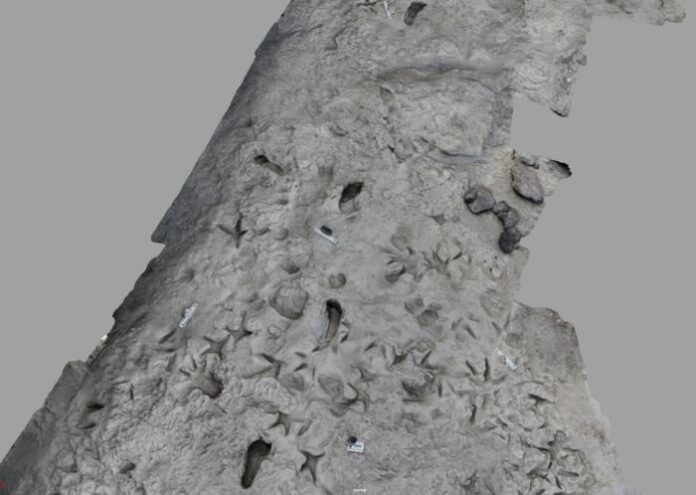About 1.5 million years ago, two different species of early man likely came within hours of passing each other on the shores of what is now known as Lake Turkana in Kenya. Two sets of footprints tracing each hominin’s path represent the first geological record of such an example, according to a report in Science.
Those footprints are part of a much larger picture that tells a more complete story of life there then.
“The footprint evidence provides a unique window into the occupation of the landscape over a short period of time,” says Craig Feibel, a geology professor at Rutgers and an author of the study. “We can actually see not only two different species of hominid, but all of these birds and antelope and everything else active on the lake margin 1.5 million years ago.”
Almost an Intra-Species Encounter?
A footprint hypothesized to have been created by a Homo erectus individual. (Credit: Photo credit: Kevin Hatala/Chatham University)
Feibel is fairly certain that the pair of prints were left within a relatively short timeframe. Since they were created on the edge of a lake, water could have eroded them, or the sun could have baked them if there was a longer period between their creations. The prints showed no sign of being washed away, either by rain or waves.
They also didn’t contain cracks, meaning it was unlikely that the sun had enough time to bake them. They were likely gently buried, perhaps by wind blowing sand or other soil on top of them, leaving them well preserved.
“It shows you they were in the same place at close to the same time,” Feibel says.
What the prints can’t prove, however, is that the two hominids passed each other or made any kind of contact. It’s fun to imagine two different types of early humans exchanging fist bumps, high fives, or fishing tales, there’s no evidence any such encounter took place.
Read More: What Is the Difference Between Early Modern Humans and Ancient Humans?
Two Proto-Humans Shared a Habitat
Although plenty of evidence shows that multiple hominids occupied Earth at the same time, the footprints provide the most conclusive signs of more than one hominid species sharing a habitat. Fossilized bones can be moved by the elements or carried away by animals, but footprints remain locked in place.
Both a level of fortuitousness and fame propelled this study. The fame came because the project was organized by Louise Leakey. She’s a third-generation paleontologist and the granddaughter of Louis Leakey — perhaps the most well-known paleontologist of all time. Feibel has worked with the Leakey Foundation in Africa since 1981.
Fortune Smiles Upon the Prepared
The fortune came about because the team was looking for bones at the site. When they unearthed the first footprint, then another, the team’s dig changed direction.
“Once they realized what they were, then they started clearing off a bigger area and found more and more footprints,” says Feibel.
Initially, it wasn’t clear that the two sets of prints were left by separate species. “I would not have recognized that they were different, certainly,” says Feibel, who visited the site after the preliminary excavation.
Read More: Discovering Our Roots: An Introduction to the History of Human Evolution
The team brought in Kevin Hatala, an author of the paper and biology professor at Chatham University in Pittsburgh. Hatala has been studying hominid footprints since 2012. After he and his team examined the footprints with multiple imaging techniques, including 3-D analysis, they determined that both the anatomy and stride patterns differed significantly enough to confidently conclude that two different species left the prints.
Such footprints can add to the story beyond what other artifacts can provide. “With these kinds of data, we can see how living individuals, millions of years ago, were moving around their environments and potentially interacting with each other, or even with other animals,” Hatala said in a press release. “That’s something that we can’t really get from bones or stone tools.”
The excavation also points to the importance of using multiple research methods to thoroughly examine a resource-dense area. “This region is so rich in fossils of all sorts — these tracks and trails — but also the bones and teeth of so many things,” says Feibel. “It’s a really exciting place to go and work because there are so many discoveries yet to be made.”
Article Sources
Our writers at Discovermagazine.com use peer-reviewed studies and high-quality sources for our articles, and our editors review for scientific accuracy and editorial standards. Review the sources used below for this article:
Before joining Discover Magazine, Paul Smaglik spent over 20 years as a science journalist, specializing in U.S. life science policy and global scientific career issues. He began his career in newspapers, but switched to scientific magazines. His work has appeared in publications including Science News, Science, Nature, and Scientific American.
Source : Discovermagazine












